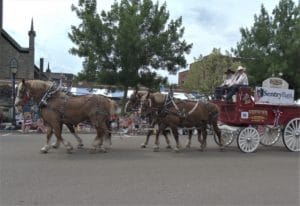by Jim Kuebelbeck
St. Joseph
For years, dedicated military veterans have traditionally marched or paraded in formation on the Fourth of July to honor those who have served their country in the armed forces. Throughout the years, this time-honored tradition was kept alive in the small community of St. Joseph as well.
To show respect for the sacrifices these veterans had made, ordinary citizens often walked behind the veterans as they marched through the community, and the day was often marked by a community-wide celebration.
To take advantage of the crowds of people congregating to honor the veterans, many local parishes and churches decided to hold annual festivals and fundraisers on this day, as did the Catholic Parish of St. Joseph.
Over time, however, interest in the community parade had waned considerably, and by the early 1960s the annual Fourth of July “parade” had dwindled down to a group of dedicated veterans, followed by small groups representing a few local businesses.
In 1964 a group of civic- minded citizens organized the St. Joseph Lions Club. Their intent (and hope) was that they would be able to assist in improving the lives and environment of the St. Joseph community. In an effort to achieve their goals, and to instill pride in “belonging” to the club, membership was (and still is) by invitation only.
Noting how the annual Fourth of July parade of citizens had decreased in numbers during the years, Lions charter members Jim Kuebelbeck, Ray Krebsbach and Leo Sadlo approached the membership with a plan to make the St. Joseph Parade an annual event people would “want” to attend.
The fledgling Lions Club, however, had very little money in reserve to embark on such an undertaking, and the proposal was met with little enthusiasm. Funds would be needed for mailings, solicitations, advertising, attracting marching bands, floats, horse groups and more.
Discussing the lack of funds with his father, Kuebelbeck learned a group of other like-minded individuals had organized the “St. Joseph Boosters Club” years ago.
At the time, the members of the Boosters Club had also hoped to keep the annual parade alive, but their efforts had failed to generate sufficient community interest, and the club subsequently became inactive.
The club had initially collected some dues and financial donations and Kuebelbeck’s father told him when the club became inactive, some of those original funds had been left in an account in the St. Joseph Bank.
The Booster Club members at the time were Max Kuebelbeck (Kuebelbeck Dairy), Claude Menzhuber (El Paso Club), “Barney” Staller (Barney’s Garage and Service Station), Sal Schneider Sr. (Sal’s Café), Al Stueve (Stueve’s Garage and Service Station), Eddie Linnemann (Linnemann’s Store), Art Loso (Loso’s Store), Bill Loso (Loso Hardware), Claude Crever (St. Joseph First State Bank), Larry Loso (Midway Bar), Oscar Jaren (Jaren’s Drug Store), Eddie Schneider (Schneider’s Café), Ray Schindler (Schindler’s Bar), Adrian Sauer (Sauer’s Store and Grocery), Agatha Gertken (St. Joseph Post Office), Oscar Krebsbach (Krebsbach Chevrolet Sales and Service Station), Norb Wander (St. Joseph Depot Agent), Darell Mensink (St. Joseph Feed Mill), Al Mohs (St. Joseph Lumber Yard), Dr. Robert Kelly (Dentist), and Al Pfannenstein Sr. (St. Benedict’s Butcher Shop).
Jim and Carol Kuebelbeck then approached bank president, Claude Crever, and asked if such an account still existed. Learning that to be the case, and that some funds were still being kept in a “dead account” at the bank, they then asked about the possibility of those funds being somehow “transferred” to the newly formed Lions Club. Crever was receptive to the idea but indicated although the Boosters Club had become inactive, any transfer of funds could only be accomplished by a meeting of the inactive members to “officially” disband the organization, and they would then (as a group) have to approve the transfer of any funds.
Carol then sent letters to all members of the inactive Boosters Club, asking them to meet one more time to officially consider the proposal.
The group met some weeks later and enthusiastically endorsed the transfer of funds. They also expressed the hope the parade might once again become an event that would draw thousands of people to the annual parish festival.
The funds from the inactive Boosters Club account were subsequently transferred to the St. Joseph Lions Club and were then used as “start up” money for what has now become an annual Fourth of July tradition in St. Joseph.
Since 1964, thanks to the continued efforts of the members of the St. Joseph Lions Club, the annual Fourth of July parade continues to be one of the most watched parades in Central Minnesota.

A perennial favorite, Notsch’s Belgian horses bring applause from the spectators at the St. Joseph Fourth of July parade.



